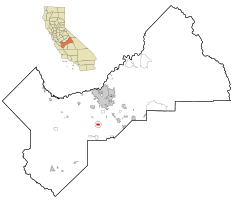Caruthers, California facts for kids
Quick facts for kids
Caruthers
|
|
|---|---|

Location in Fresno County and the state of California
|
|
| Country | |
| State | |
| County | Fresno |
| Area | |
| • Total | 2.02 sq mi (5.24 km2) |
| • Land | 2.02 sq mi (5.24 km2) |
| • Water | 0.00 sq mi (0.00 km2) 0% |
| Elevation | 246 ft (75 m) |
| Population
(2020)
|
|
| • Total | 2,613 |
| • Density | 1,291.65/sq mi (498.82/km2) |
| Time zone | UTC-8 (PST) |
| • Summer (DST) | UTC-7 (PDT) |
| ZIP code |
93609
|
| Area code(s) | 559 |
| FIPS code | 06-11614 |
| GNIS feature IDs | 277485, 2407976 |
Caruthers is a small community in Fresno County, California, United States. It is known as a census-designated place (CDP). This means it's a special area defined by the government for counting people.
In 2020, about 2,613 people lived in Caruthers. It is located about 15 miles (24 km) south of downtown Fresno. Caruthers sits at an elevation of 246 feet (75 meters) above sea level.
Contents
Caruthers: Location and Size
Caruthers is located in the sunny state of California. It is part of Fresno County. The community covers a total area of about 2.0 square miles (5.2 square kilometers). All of this area is land. There are no large bodies of water within Caruthers itself.
Caruthers: A Look at Its History
The first post office in Caruthers opened in 1891. The town was named after W.A. Caruthers, who was a farmer in the area.
The Fresno County Public Library opened a branch in Caruthers in 1911. It was first located in the town's hotel. Over the years, the library moved to different spots. In 2003, it found its current home. The building was designed to look like an old tank house and barn.
Who Lives in Caruthers?
The population of Caruthers has grown over the years. In 2000, there were 2,103 people. By 2010, the population had increased to 2,497. The most recent count in 2020 showed 2,613 people living there.
Many different groups of people live in Caruthers. In 2010, about 63.7% of the people identified as Hispanic or Latino. The community is a mix of different backgrounds and cultures.
Most people in Caruthers live in family homes. In 2010, about 99.6% of the population lived in households. Many homes had children under 18 living in them. The average household size was about 3.89 people.
The Fun Caruthers Fair
One of the most famous events in the area is the Caruthers District Fair. It started way back in 1923. At first, some people in the community were unsure about starting it. They worried about the work and costs.
The very first fair included a football game. The Caruthers team played against Fresno State. Caruthers lost the game 41–0. In the early years, the fair even had races where people rode sheep!
Every year, a fair queen is chosen. Girls sell tickets during the summer to help raise money for the fair. The girl who sells the most tickets becomes the fair queen. It's a big tradition for the community.
See also
 In Spanish: Caruthers para niños
In Spanish: Caruthers para niños


